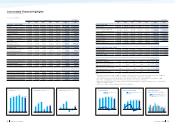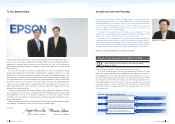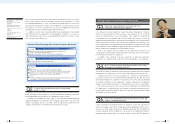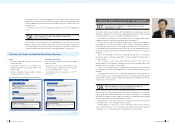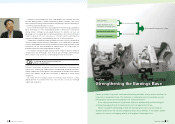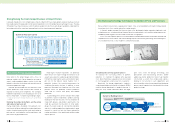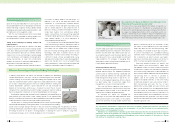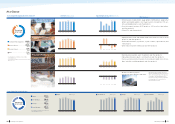Epson 2008 Annual Report Download - page 9
Download and view the complete annual report
Please find page 9 of the 2008 Epson annual report below. You can navigate through the pages in the report by either clicking on the pages listed below, or by using the keyword search tool below to find specific information within the annual report.
14 Seiko Epson Corporation
15Annual Report 2008
Variable Cost Reductions: The Second Stage
Since the fiscal year ended March 31, 2005, Epson has
firmly established the necessity of building to cost from the
product and design stages by creating a product design
roadmap based on reducing the number of platforms, and
by improving its cost management system.
With this new thinking in place, Epson next entered
the stage where it attempted to reduce variable costs
by making products that are smaller and lighter.
Taking on the challenge of building smaller and
lighter products
Reducing the size and weight of a printers main body
casing is an important factor not only in lowering variable
costs, but in reducing the number of platforms and the
variety and number of parts per unit. Besides lowering
material costs, this can also lower logistics and packaging
costs. In recent years, with corporate social responsibility
driving manufacturers to lower their environmental
footprint, the creation of smaller and lighter products is
becoming an increasingly important issue.
Epson is now emphasizing the following four points
in its efforts to reduce product size and weight: 1. a
reduction in the size of the inkjet print head, a key
component, 2. increased parts installation density,
3. the creation of thinner and lighter main body casing
and 4. a further reduction in the number of parts. In
particular, creating a smaller print head does more than
simply lower material costs and decrease product
weight, it also promises to increase printing speed and
contribute to better performance. Moreover, achieving a
more compact design is of critical importance to
achieving greater design flexibility.
In fact, production technology developed by Epson
in the manufacturing of watches and printers holds an
important key to creating smaller and lighter products.
Print heads can be made more compact through
precision machining technology and ink ejection control
technology, while parts installation density can be
improved with installation and assembly technology. It
is difficult to create a thinner and lighter body casing
and reduce the number of parts while retaining product
quality and strength, but it can be achieved through
further improvements in die machining technology and
the plastic molding technology that supports it.
Creating a Structure for Reducing Fixed Costs
As earlier stated, Epson hopes to achieve higher production
yields and better quality from a reduction in the number of
platforms and the variety and number of parts per unit,
assuming the long-term use of these fewer platforms and
parts. Because this will, as a result, enable consistent and
stable production; the Company is leveraging those
advantages to create a system for reducing fixed costs as
it seeks greater operational efficiency.
Greater operational efficiency
At present, seasonal factors greatly influence inkjet printer
demand. Because Epson has adopted a production
system based on inventory planning coordinated with
peaks in demand, inventory risks are high due to sales
trends during peak selling seasons. In light of this, as it
works to achieve greater operational efficiency, Epson
has been taking steps to restructure supply chain
management as a means of reducing inventory.
The issue that Epsons operations have faced is a
tendency to hold too much inventory, which stems from
the Companys desire to avoid, as far as possible, lost
opportunities caused by late product delivery.
To overcome this, Epson has leveraged the
advantages of consistent and stable production while
reducing the transport cycle to points of consumption
and, at the same time, ensuring reliable shipment and
delivery. Furthermore, Epson has instituted a system
that checks for sales opportunity losses and inventory
trends from both the sales and manufacturing sides,
thus enabling it to respond to day-to-day fluctuations.
As a result, the Company has succeeded in reducing
inventories thanks to having established and confirmed
that its operations are able to achieve sales targets,
even if basic inventories decline. Epson will continue its
efforts to achieve ever greater operational efficiency.
Aside from lowering inventory risk, benefits that
Epson expects from restructuring its supply chain
management system as a means of reducing inventory
include the less frequent use of production equipment
and systems owing to decreases in demand peaks for
basic inventory and the stabilization of quality by keeping
manufacturing levels as constant as possible. In
addition, due to the leveling and stabilization of
production and product delivery, as well as the sharing
of information related to sales and inventory trends in
both manufacturing and sales, the loss of sales
opportunities can be avoided, and sales contracts (and
plans) can be achieved. It has also become possible to
take close control of the progress of business plans,
and to propose solutions to issues on a timely basis. As
a result, Epson expects that it will be able to curb costs
through reduced sales promotion costs due to more
efficient calculation of the timing and scale of promotions
required to generate sales.
Extrusion Processing and Injection Molding Technologies
In reducing inkjet printer size, Epson can leverage its experience in developing
compact photo printers. One way it can do this is by reducing the size of the tubes
used for sending ink to the print head and bundling them together. Epson took
tubes that had formerly been used for single colors and bundled them into a single
set of tubes created through plastic extrusion molding. Moreover, working with
material development specialists, Epson reduced the size and increased the
flexibility of the new tubes. Another way is to reduce the size of the ink channel
component that is attached to each end of the tube. Using plastic injection molding,
Epson configured the component so that ink flowed properly without leaking.
Bundling the separate tubes and reducing the component size allowed Epson to
lower material costs and achieve a more compact design. As for improved tube
flexibility, cutting back on the amount of space needed to ensure range of movement
made it possible to achieve an even more compact printer design.
The key points in working with these different plastic processing technologies
are to extrude after properly inserting the material̶in the case of extrusion molding̶
and to create a stronger sealing to the tube̶in the case of injection molding. Both considerations are key to
achieving mold shapes, and, here too, Epson is putting its accumulated know-how related to mold machining
technology to practical use. Epson is making progress in reducing the size of its products using mold
machining technologies, which it intends to deploy in most of its products.
Takao Kanai
General Administrative Manager
Message from the General Administrative Manager of the
Production & Procurement General Center
To increase both net sales and profitability in the medium- to long-term, it is
essential for Epson to improve its competitiveness as a manufacturer. In the
Production & Procurement General Center, we are seeking to achieve this from
two angles: by making improvements in both our products and in our
operations. I believe that we can contribute to improved competitiveness by
leveraging our core proprietary technology to strengthen our product capability,
and by improving operational efficiency from manufacturing through to sales.
Change in tube design
Bundled tubes
Individual tubes
The competitive environment is expected to intensify as economic globalization increases. For Epson to
retain its competitive edge, especially in this environment, it is vital that it sustain its cost-cutting activities
and institute a cost-management system.
Building to cost allows Epson to improve quality while making possible the overall elimination of waste in
operations, factors that contribute to stronger cost-competitiveness. By continuing this virtuous circle of
cost reductions and quality improvements and applying value creation principles in all businesses, Epson
will continue to strengthen its earnings base.



